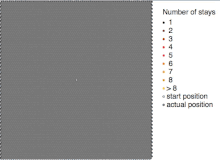
Back Brownse beweging Afrikaans حركة براونية Arabic Movimientu brownianu AST Broun hərəkəti Azerbaijani Броўнаўскі рух Byelorussian Брауново движение Bulgarian ব্রাউনীয় গতি Bengali/Bangla Moviment brownià Catalan Brownův pohyb Czech Броун куçăмĕ CV


Brownian motion is the random motion of particles suspended in a medium (a liquid or a gas).[2]
This motion pattern typically consists of random fluctuations in a particle's position inside a fluid sub-domain, followed by a relocation to another sub-domain. Each relocation is followed by more fluctuations within the new closed volume. This pattern describes a fluid at thermal equilibrium, defined by a given temperature. Within such a fluid, there exists no preferential direction of flow (as in transport phenomena). More specifically, the fluid's overall linear and angular momenta remain null over time. The kinetic energies of the molecular Brownian motions, together with those of molecular rotations and vibrations, sum up to the caloric component of a fluid's internal energy (the equipartition theorem).[citation needed]
This motion is named after the botanist Robert Brown, who first described the phenomenon in 1827, while looking through a microscope at pollen of the plant Clarkia pulchella immersed in water. In 1900, the French mathematician Louis Bachelier modeled the stochastic process now called Brownian motion in his doctoral thesis, The Theory of Speculation (Théorie de la spéculation), prepared under the supervision of Henri Poincaré. Then, in 1905, theoretical physicist Albert Einstein published a paper where he modeled the motion of the pollen particles as being moved by individual water molecules, making one of his first major scientific contributions.[3]
The direction of the force of atomic bombardment is constantly changing, and at different times the particle is hit more on one side than another, leading to the seemingly random nature of the motion. This explanation of Brownian motion served as convincing evidence that atoms and molecules exist and was further verified experimentally by Jean Perrin in 1908. Perrin was awarded the Nobel Prize in Physics in 1926 "for his work on the discontinuous structure of matter".[4]
The many-body interactions that yield the Brownian pattern cannot be solved by a model accounting for every involved molecule. Consequently, only probabilistic models applied to molecular populations can be employed to describe it.[5] Two such models of the statistical mechanics, due to Einstein and Smoluchowski, are presented below. Another, pure probabilistic class of models is the class of the stochastic process models. There exist sequences of both simpler and more complicated stochastic processes which converge (in the limit) to Brownian motion (see random walk and Donsker's theorem).[6][7]
- ^ Meyburg, Jan Philipp; Diesing, Detlef (2017). "Teaching the Growth, Ripening, and Agglomeration of Nanostructures in Computer Experiments". Journal of Chemical Education. 94 (9): 1225–1231. Bibcode:2017JChEd..94.1225M. doi:10.1021/acs.jchemed.6b01008.
- ^ Feynman, Richard (1964). "The Brownian Movement". The Feynman Lectures of Physics, Volume I. p. 41.
- ^ Einstein, Albert (1905). "Über die von der molekularkinetischen Theorie der Wärme geforderte Bewegung von in ruhenden Flüssigkeiten suspendierten Teilchen" [On the Movement of Small Particles Suspended in Stationary Liquids Required by the Molecular-Kinetic Theory of Heat] (PDF). Annalen der Physik (in German). 322 (8): 549–560. Bibcode:1905AnP...322..549E. doi:10.1002/andp.19053220806. Archived (PDF) from the original on 9 October 2022.
- ^ "The Nobel Prize in Physics 1926". NobelPrize.org. Retrieved 29 May 2019.
- ^ Tsekov, Roumen (1995). "Brownian motion of molecules: the classical theory". Ann. Univ. Sofia. 88: 57. arXiv:1005.1490. Bibcode:1995AUSFC..88...57T.
the behavior of a Brownian particle is quite irregular and can be described only in the frames of a statistical approach.
- ^ Knight, Frank B. (1 February 1962). "On the random walk and Brownian motion". Transactions of the American Mathematical Society. 103 (2): 218–228. doi:10.1090/S0002-9947-1962-0139211-2. ISSN 0002-9947.
- ^ "Donsker invariance principle - Encyclopedia of Mathematics". encyclopediaofmath.org. Retrieved 28 June 2020.
© MMXXIII Rich X Search. We shall prevail. All rights reserved. Rich X Search